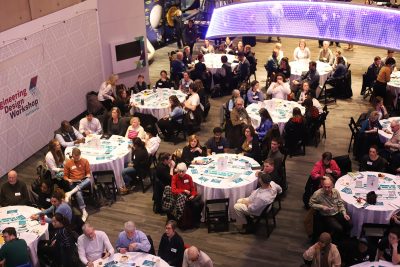Climate change is often associated with daunting images of melting polar ice caps, raging wildfires and rising sea levels. The existential threat posed by this phenomenon is causing some to feel anxiety and fear of environmental doom. For others, it raises questions about effective solutions.

At the Wicked High Tides Forum hosted by the Museum of Science on Tuesday night, approximately 120 attendees had the opportunity to learn about another solution for climate change and its potential in averting it.
Climate resilience — the ability to anticipate, prepare for and respond to disastrous climate events — was described to the audience in an interactive, role-playing exercise.
Sara Benson, an education associate at the museum, presented the case of the fictitious Massachusetts town, Kingtown, for participants to explore.
“You’re going to be exploring the problems the town faces with sea level rise and talking about what resiliency plans that you would to implement as a team,” Benson said during the talk.
Participants were asked to consider six different Kingtown residents, unique in their backstories, race and socioeconomic class. Each character had different concerns on the rising sea levels and desired outcomes. Characters included Andrea, a power plant CEO who feared flood-proofing her plant could be costly, and Matthew, an oyster farmer who ran his family’s mussel and oyster business and was worried about his financial future.
After an hour of discussion, attendees were given fake currency and asked to purchase a resilience plan — keep water out, living with water, or managed retreat — that aligned with the residents’ interests.
Following the exercise, Julie Wormser, deputy director of the Mystic River Watershed Association, a non-profit organization that aims to protect water bodies, talked about sea level rise in Boston.
Even with shifting from cars to bicycles, elevators and escalators to stairs and all other means of alternative carbon emissions, Wormser said the emissions would not decrease enough to reverse climate change.
“We [would] still see about two and a half meters [of sea water], half of my height, by the end of the century,” Wormser said. “We don’t know how good we’re going to get at decreasing carbon emission.”
Boston, in its coastal location, has had its fair share of flooding, Wormser said, and shared the areas of the city that were man made.
“All of these areas that are super flood-prone are areas that our ancestors filled in to make more elbow room,” Wormser said in her talk, “[which] gave us a tremendous design challenge as those areas are starting to flood.”
Wormser said the infrastructure of Boston, while ready for New England winters, cannot hold up against the increased and fiercer storms brought on by climate change.
“This is where you get flooding in subways, flooding in people’s basements,” Wormser said in her talk. “Our communities are not ready for this level of rain.”
Preventing flood damages rather than preventing flooding itself, Wormser said, would be a more viable option for the city.
“Boston will have to be different,” Wormser said at the end of her talk, “but it doesn’t have to be worse.”
Attendee Melanie Garate, a climate resiliency project manager at the Mystic River Watershed Association, said she became involved in climate resilience from her experience in marine science and in seeing how people in varying socioeconomic groups are affected by climate change.
“I was looking for many years on how climate change is being affected by people,” Garate said in an interview. “I realized that there were lots of people who were being negatively affected by climate change impacts who didn’t necessarily make the biggest contributions to climate change.”


























































































































